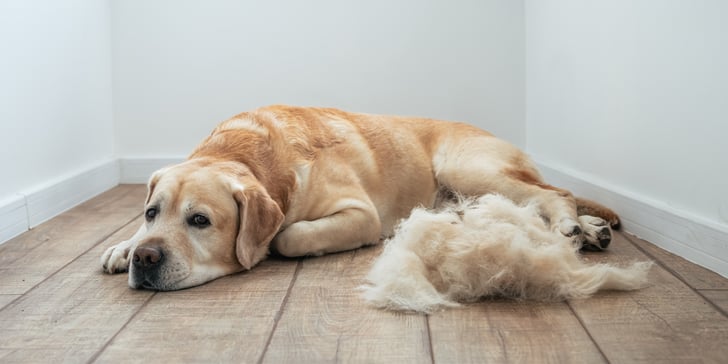Do Labrador Retrievers Shed a Lot? Understanding Labrador Shedding
Index:



When do Labrador Retrievers shed a lot? Understanding Labrador shedding
If you're a proud Labrador Retriever owner or considering bringing one of these lovable furballs into your home, you've likely wondered about their shedding habits.
Labradors shed a lot, and it's essential to understand when and why this happens to keep your home (and sanity) intact.
Let's dive into the world of Labrador shedding and uncover everything you need to know about managing your furry friend's coat.
The Labrador Retriever coat
Before we delve into the when and why of Labrador shedding, it's crucial to understand the unique characteristics of their coat. Labrador Retrievers have a double coat consisting of two layers:
A dense, soft undercoat that provides insulation
A water-resistant topcoat that protects them from the elements
This double coat is excellent for keeping your Lab comfortable in various weather conditions, but it also means they're prone to heavy shedding.



When do Labradors shed the most?
Labradors shed throughout the year, but there are specific times when shedding intensifies. Here's a breakdown of the Labrador shedding calendar:
Spring shedding: the big blow
As temperatures rise, your Lab will shed their thick winter coat to prepare for warmer weather.
This period, often referred to as "blowing coat," typically occurs in late spring and can last for several weeks.
During this time, you might find clumps of hair around your home and wonder if your Lab will have any fur left!
Fall shedding - preparing for winter
In autumn, Labs shed their lighter summer coat to make way for a thicker winter coat. This shedding period is usually less intense than the spring shed but still noticeable.
Year-round shedding
While the spring and fall are peak shedding seasons, Labradors shed to some degree all year.
This year-round shedding is typically less intense but consistent, requiring regular grooming to manage.
Factors that influence Labrador shedding
The amount of shedding can vary from one Lab to another. Several factors influence how much your Labrador sheds:
Genetics: Some Labs are simply predisposed to shed more than others.
Diet: A balanced diet rich in essential nutrients can promote healthy skin and coat, potentially reducing excessive shedding.
Health: Certain health issues can cause increased shedding or hair loss.
Environment: Indoor Labs living in temperature-controlled environments may shed more consistently throughout the year.
Stress: Like humans, dogs can experience stress-related hair loss.
Is my lab shedding too much?
While Labradors are notorious shedders, there's a difference between normal shedding and excessive shedding. If you notice any of the following signs, it might be time to consult your vet:
Bald patches or thinning fur
Skin irritation, redness, or scabs
Dull, dry, or brittle coat
Sudden increase in shedding not related to seasonal changes
Remember, a healthy Lab's shedding should be relatively consistent (aside from seasonal changes) and not accompanied by skin issues or changes in coat quality.



Managing your Lab's shedding - tips and tricks
While you can't stop a Labrador Retriever's natural shedding process, there are several ways to manage it effectively:
1. Regular brushing - your first line of defense
Brush your Lab at least once a week, increasing to daily during heavy shedding seasons. This helps remove loose hair before it ends up on your furniture. Our guide on dog grooming tools can help you choose the right brush for your Lab's coat.
2. Bathing - clean and control
Regular baths can help reduce shedding by removing dead hair. However, don't overdo it – bathing too frequently can dry out your Lab's skin and potentially increase shedding. Aim for a bath every 4-6 weeks, or as recommended by your vet.
3. Nutrition - feed for the coat
A high-quality diet rich in omega-3 and omega-6 fatty acids can promote a healthy coat and potentially reduce shedding. Consider adding fish oil supplements to your Lab's diet after consulting with your vet.
4. Control environmental factors
Keep your home at a consistent temperature to reduce the impact of seasonal changes on your Lab's coat. This can help manage shedding patterns, especially for indoor dogs.
5. Regular vet check-ups
Annual check-ups can help catch any health issues that might be causing excessive shedding before they become serious problems.
The great debate: do some Lab colours shed more?
You might have heard rumours that certain Lab colours shed more than others. Let's put this myth to rest:
The truth is, all Labradors shed a lot, regardless of their colour. The perception that one colour sheds more might be due to the visibility of the hair on different coloured surfaces rather than actual shedding volume.
Living with a shedding Lab - home management tips
Living with a Lab means accepting a certain amount of dog hair as part of your decor. Here are some tips to keep your home relatively fur-free:
Invest in a good quality vacuum cleaner designed for pet hair.
Use washable slipcovers on furniture.
Keep lint rollers handy for quick clean-ups.
Consider using air purifiers to help with airborne pet dander.
Remember, while these tips can help, they won't eliminate shedding entirely. Embracing a bit of fur is part of the joy of Labrador ownership!



The silver lining of shedding
While Labrador shedding can be frustrating, it's important to remember the positive aspects of your Lab's coat.
Their water-resistant double coat is part of what makes Labs such excellent swimmers and retrievers.
It's a testament to their heritage as working dogs and part of what makes them uniquely suited to various activities and climates.
Moreover, the shedding process is a natural and healthy part of your Lab's life cycle. It's their body's way of maintaining a healthy coat and adapting to changing seasons.
By helping your Lab through their shedding seasons, you're contributing to their overall health and comfort.
Conclusion - embracing your shedding Labrador
Labradors shed – it's a fact of life for Lab owners. But with proper care, regular grooming, and a bit of patience, you can manage your Lab's shedding effectively.
Remember, the love, loyalty, and joy your Lab brings to your life far outweighs the inconvenience of a little (or a lot) of dog hair.
By understanding your Lab's shedding patterns and implementing a good grooming routine, you can keep your Lab's coat healthy and your home relatively fur-free.
And on those days when you feel overwhelmed by the fur, just remember – it's all part of the package when you love a Lab!Curious about how Lab shedding compares to other breeds?
Check out our comparison of Cocker Spaniels and Springer Spaniels for insights into other popular sporting breeds.And don't forget – a healthy dog is a happy dog.
Consider getting a quote for pet insurance to ensure your Lab stays in top shape, shedding season and all!
For more scientific insights into canine shedding patterns, the American Kennel Club offers a comprehensive guide that delves into the biological aspects of dog shedding.
Waggel Pet Insurance
Need more help? You're in luck if you're a Waggel Pet Insurance member. Along with our excellent coverage, we offer access to a 24/7 online vet to answer all your sticky questions, especially if you need grooming assistance.
Not a member? Why not get a quote now and cover your furry friend for a range of illnesses, all while enjoying our amazing perks and rewards.
Want more like this?
Get updates from us with helpful info, advice, answers to frequently asked questions and much more.
Index:
- When do Labrador Retrievers shed a lot? Understanding Labrador shedding
- The Labrador Retriever coat
- When do Labradors shed the most?
- Factors that influence Labrador shedding
- Is my lab shedding too much?
- Managing your Lab's shedding - tips and tricks
- The great debate: do some Lab colours shed more?
- Living with a shedding Lab - home management tips
- The silver lining of shedding
- Conclusion - embracing your shedding Labrador
Related posts:
Get your quote
Along with our excellent coverage, we offer access to a 24/7 online vet to answer all your sticky questions.





